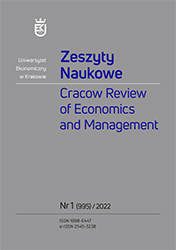The Use of DEA Methodology in the Analysis of Football Club Efficiency
DOI:
https://doi.org/10.15678/ZNUEK.2022.0995.0106Keywords:
Data Envelopment Analysis, financial performance, financial revenues, financial costs, efficiency indicator, sports performanceAbstract
Objective: The aim of the article is twofold: to determine the efficiency of football clubs in the English league, one of the leading football leagues in the world, and to understand the usefulness of the DEA method in assessing football club efficiency.
Research Design & Methods: The research was done using DEA, one of the most popular methods for assessing the efficiency of football clubs.
Findings: The research and DEA method enabled a ranking of the most effective English football clubs. Leicester City, Reading, Fulham and Burnley were among the best performers, though only a single club, Manchester United, proved efficient in all of the seasons analysed. In the majority of the seasons analysed, all of the variables identified as potentially significant had a positive impact on the quality of the model used to assess efficiency.
Implications / Recommendations: The combination of high revenues and good sports results achieved in international competitions make English football clubs highly efficient. In most cases, the top sports clubs are among the teams that finish highest on the performance index.
Contribution: The analysis confirms the usefulness of the DEA method in the analysis of football club efficiency. It also enables the comprehensive evaluation of the functioning of English football clubs, including both their financial and sports results.
Downloads
References
Annual Review of Football Finance (2021), Deloitte Sports Business Group.
Domagała A. (2009), Zastosowanie metody Data Envelopment Analysis do badania efektywności europejskich giełd papierów wartościowych, Uniwersytet Ekonomiczny w Poznaniu, Poznań.
Färe R., Lovell C.A.K. (1978), Measuring the Technical Efficiency of Production, ,,Journal of Economic Theory”, vol. 19(1). DOI: https://doi.org/10.1016/0022-0531(78)90060-1
Football Money League (2021), Deloitte Sports Business Group.
Freitas M., Flach L., Sousa Farias R. (2017), Efficiency Determinants in Brazilian Football Clubs, ,,Brazilian Business Review”, vol. 14 (special ed.), https://doi.org/10.15728/edicaoesp.2017.1. DOI: https://doi.org/10.15728/edicaoesp.2017.1
Guzman-Raja I., Guzman-Raja M. (2021), Measuring the Efficiency of Football Clubs Using Data Envelopment Analysis, ,,SAGE journals”, 1 lutego, https://doi.org/ DOI: https://doi.org/10.1177/2158244021989257
1177/2158244021989257.
Halkos G., Tzeremes N. (2011), A Non-Parametric Analysis of the Efficiency of the Top European Football Clubs, ,,MPRA Paper” no 31173, University Library of Munich.
Halkos G., Tzeremes N. (2012), A Two-Stage Double Bootstrap DEA: The Case of the Top 25 European Football Clubs’ Efficiency Levels, ,,Managerial and Decision Economics”, vol. 34(2), https://doi.org/10.1002/mde.2597. DOI: https://doi.org/10.1002/mde.2597
Haq Bhat Z., Sultana D., Bashir Lone S. (2017), Efficiency Evaluation of Football Teams in English Premier League: Application of Data Envelopment Analysis, ,,International Journal of Data Envelopment Analysis”, vol. 5(4).
Jardin M. (2009), Efficiency of French Football Clubs and its Dynamics, ,,MPRA Paper” no 19828, University of Munich.
Kulikova L.I., Goshunova A.V. (2014), Efficiency Measurement of Professional Football Clubs: A Non-Parametric Approach, ,,Life Science Journal”, nr 11.
Pestana Barros C., Garcia-del-Barrio P. (2011), Productivity Drivers and Market Dynamics in the Spanish First Division Football League, ,,Journal of Productivity Analysis” vol. 35(1), https://doi.org/10.1007/s11123-010-0196-9. DOI: https://doi.org/10.1007/s11123-010-0196-9
Pyatunin A., Vishnyakova A., Sherstneva N., Mironova S., Dneprov S., Grabozdin Y. (2016), The Economic Efficiency of European Football Clubs – Data Envelopment Analysis (DEA) Approach, ,,International of Journal Environmental and Science Education”, vol. 11(15).
Ribeiro A., Lima F. (2012), Portuguese Football League Efficiency and Players’ Wages, ,,Applied Economic Letters”, vol. 19(6), https://doi.org/10.1080/13504851.2011.591719. DOI: https://doi.org/10.1080/13504851.2011.591719
Tiedemann T., Francksen T., Latacz-Lohmann U. (2010), Assesing the Performance of German Bundesliga Football Players: A Non-Parametric Metafrontier Approach, ,,Central European Journal of Operations Research”, vol. 19(4), https://doi.org/10.1007/s10100-010-0146-7. DOI: https://doi.org/10.1007/s10100-010-0146-7
Villa G., Lozano S. (2016), Assesing the Scoring Efficiency of a Football Match, ,,European Journal of Operational Research”, vol. 255(2), https://doi.org/10.1016/j.ejor.2016.05.024. DOI: https://doi.org/10.1016/j.ejor.2016.05.024
Wyszyński A. (2017), Sytuacja finansowa klubów Ekstraklasy w ujęciu metody DEA, ,,Gospodarka Narodowa”, nr 288(2), https://doi.org/10.33119/GN/100742. DOI: https://doi.org/10.33119/GN/100742
Downloads
Published
Issue
Section
License
Copyright (c) 2022 Zeszyty Naukowe Uniwersytetu Ekonomicznego w Krakowie / Cracow Review of Economics and Management

This work is licensed under a Creative Commons Attribution 4.0 International License.

